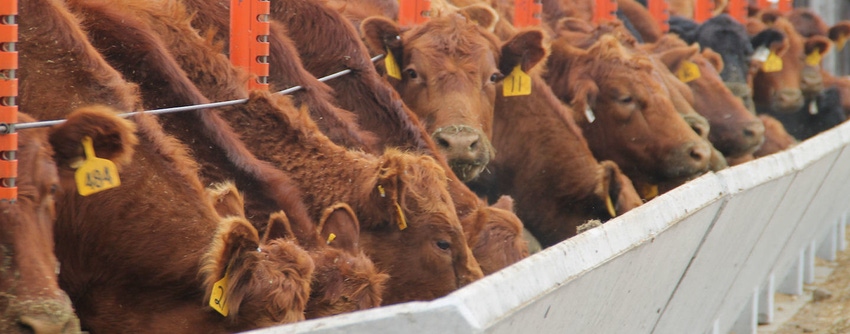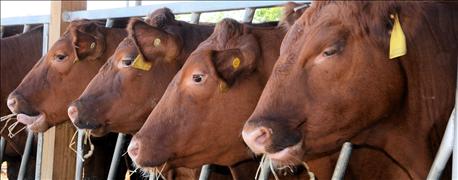January 23, 2016

Indoor, confined feedlots maintain efficient growth and feed conversion in northern climates, especially in areas with heavy rain and snowfall. The feedlots control manure runoff better, which is important in the Great Lakes watershed. Better manure management, especially in feedlots with slatted floors and underground pits, reduces nitrogen loss for better fertilizer use and keeps animals cleaner. Less manure tag increases dressing percentage and reduces carcass contamination risk during slaughter.
However, indoor, confined feedlots, especially those with slatted floors, have more incidence of lameness and tail tip injuries. Putting feeders in close confinement can also speed disease spread. The question then becomes, how do you manage these health concerns?
 Confined cattle can be productive provided you manage health needs with attention to detail.
Confined cattle can be productive provided you manage health needs with attention to detail.
Risk of pathogen spread
Pathogens are present in all feedlots but close confinement makes transmission more likely. With respiratory disease, airborne pathogen concentration depends on many factors, including animal type, age, breed, sex, housing system, stocking density, bedding, humidity, dust particle density and size, noxious gas concentrations, and ventilation.
Improved ventilation is the No. 1 way to reduce airborne pathogen concentration, says Dan Grooms, Doctor of Veterinary Medicine (DVM) and chair of Michigan State University’s (MSU) Department of Large Animal Clinical Sciences.
However, as airborne pathogen load increases, ventilation provides progressively less protection against respiratory pathogens. A two-fold increase in stocking density requires nearly a 10-fold increase in ventilation to maintain the same airborne pathogen density. The high stocking density of indoor, confined feedlots naturally increases pathogen loads and can be exacerbated by poorly ventilated systems.
Natural ventilation can be improved by opening up sidewalls and ridge vents. Appropriately sized and located fans can improve mechanical ventilation. It may be best to work with a ventilation expert to correctly design the best system for the facility.
Proper pre-conditioning is a good way to reduce the risk of respiratory disease and other health issues in feedlots. Know the vaccination history of the calves received. MSU’s Grooms says the recommended vaccinations for common respiratory disease include Infectious Bovine Rhinotracheitis (IBR), Bovine Viral Diarrhea Types 1 and 2 (BVDV), Para Influenza-3 (PI-3), and Bovine Respiratory Syncytial Virus (BRSV), and bacterial pathogens, most importantly Mannheimia haemolytica.
Lameness
This is a persistent problem, regardless of the housing system. The reported incidence of lameness in feedlots has changed little in the past 10 years. Lameness is particularly persistent in indoor, confined feedlots with concrete, slatted floors.
Foot rot, toe abscesses and mechanical injuries are often reported as the most common causes of lameness in the outdoor feedlots of the western U.S. However, field reports of lameness in upper Midwest, indoor, confined feedlots indicate heel warts and polyarthritis (multiple-joint arthritis) may be more common causes.
Feeding high concentrate, high energy diets can cause foot inflammation and make lameness more severe. Breed, age, days on feed, and stocking density are also factors to consider. Many producers use rubber-covered floors to help reduce lameness, but conclusive research on the practice has yet to come.
“Many times, these issues come down to stocking density, and managing density is a practice feedlot producers always need to consider,” says Lee Anne Kroll, MS, DVM at Standish, Michigan, and co-author with MSU’s Grooms of a recent report on health issues in confined feedlots.
Tail tip injuries
Tail tip injuries are more persistent problems on slatted floors than solid concrete or dirt floors, or deep bedding packs.
Tail docking is often used to reduce tail tip injuries. However, recent MSU research was unable to find any advantage to the practice on performance parameters, carcass traits or on animal health. Researchers also couldn’t link tail injury to increased lameness.
Researchers also observed an increase in step counts, a measure of activity level, in the two weeks after tail docking. This may be because of pain from docking. Tail removal also takes away the ability to swat flies and calves could be moving to avoid or dislodge flies. Walking activity has been shown to be significantly increased in yearling feedlot steers under high levels of fly irritation.
Good sanitation is the key to fly control. A comprehensive, insect control plan could also include reducing organic material such as manure piles and rotten feed (which are all breeding grounds for flies), proper feed storage, minimizing standing water and wet areas, labeled uses of facility and/or animal insecticides, and parasitic wasps.
Other health hazards
Several noxious gases can exist in enclosed manure pits, but hydrogen sulfide is the most dangerous. Agitating manure pits under confined feedlots can expose animals to high concentrations of the gas.
Hydrogen sulfide is highly toxic and is produced by the anaerobic decomposition of sulfur-containing organic matter. Hydrogen sulfide has a low water solubility and much of the gas is trapped in bubbles in the manure. Agitation before pumping can release the gas, in lethal concentrations, into the facility.
Hydrogen sulfide is heavier than air. Keeping pit levels a few feet below floor level reduces exposure risk. This may mean pumping out some manure before agitation.
Some research has shown adding a metallic salt to the manure impacts the sulfur cycle and can reduce emissions. Hydrogen sulfide detectors are also available.
- Peterson writes from Michigan
You May Also Like




